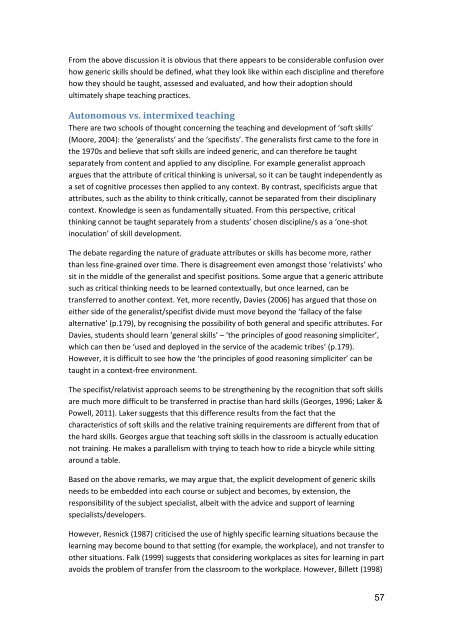Teaching and Assessing Soft Skills - MASS - Measuring and ...
Teaching and Assessing Soft Skills - MASS - Measuring and ...
Teaching and Assessing Soft Skills - MASS - Measuring and ...
Create successful ePaper yourself
Turn your PDF publications into a flip-book with our unique Google optimized e-Paper software.
From the above discussion it is obvious that there appears to be considerable confusion over<br />
how generic skills should be defined, what they look like within each discipline <strong>and</strong> therefore<br />
how they should be taught, assessed <strong>and</strong> evaluated, <strong>and</strong> how their adoption should<br />
ultimately shape teaching practices.<br />
Autonomous vs. intermixed teaching<br />
There are two schools of thought concerning the teaching <strong>and</strong> development of ‘soft skills’<br />
(Moore, 2004): the ‘generalists’ <strong>and</strong> the ‘specifists’. The generalists first came to the fore in<br />
the 1970s <strong>and</strong> believe that soft skills are indeed generic, <strong>and</strong> can therefore be taught<br />
separately from content <strong>and</strong> applied to any discipline. For example generalist approach<br />
argues that the attribute of critical thinking is universal, so it can be taught independently as<br />
a set of cognitive processes then applied to any context. By contrast, specificists argue that<br />
attributes, such as the ability to think critically, cannot be separated from their disciplinary<br />
context. Knowledge is seen as fundamentally situated. From this perspective, critical<br />
thinking cannot be taught separately from a students’ chosen discipline/s as a ‘one-shot<br />
inoculation’ of skill development.<br />
The debate regarding the nature of graduate attributes or skills has become more, rather<br />
than less fine-grained over time. There is disagreement even amongst those ‘relativists’ who<br />
sit in the middle of the generalist <strong>and</strong> specifist positions. Some argue that a generic attribute<br />
such as critical thinking needs to be learned contextually, but once learned, can be<br />
transferred to another context. Yet, more recently, Davies (2006) has argued that those on<br />
either side of the generalist/specifist divide must move beyond the ‘fallacy of the false<br />
alternative’ (p.179), by recognising the possibility of both general <strong>and</strong> specific attributes. For<br />
Davies, students should learn ‘general skills’ – ‘the principles of good reasoning simpliciter’,<br />
which can then be ‘used <strong>and</strong> deployed in the service of the academic tribes’ (p.179).<br />
However, it is difficult to see how the ‘the principles of good reasoning simpliciter’ can be<br />
taught in a context-free environment.<br />
The specifist/relativist approach seems to be strengthening by the recognition that soft skills<br />
are much more difficult to be transferred in practise than hard skills (Georges, 1996; Laker &<br />
Powell, 2011). Laker suggests that this difference results from the fact that the<br />
characteristics of soft skills <strong>and</strong> the relative training requirements are different from that of<br />
the hard skills. Georges argue that teaching soft skills in the classroom is actually education<br />
not training. He makes a parallelism with trying to teach how to ride a bicycle while sitting<br />
around a table.<br />
Based on the above remarks, we may argue that, the explicit development of generic skills<br />
needs to be embedded into each course or subject <strong>and</strong> becomes, by extension, the<br />
responsibility of the subject specialist, albeit with the advice <strong>and</strong> support of learning<br />
specialists/developers.<br />
However, Resnick (1987) criticised the use of highly specific learning situations because the<br />
learning may become bound to that setting (for example, the workplace), <strong>and</strong> not transfer to<br />
other situations. Falk (1999) suggests that considering workplaces as sites for learning in part<br />
avoids the problem of transfer from the classroom to the workplace. However, Billett (1998)<br />
57





